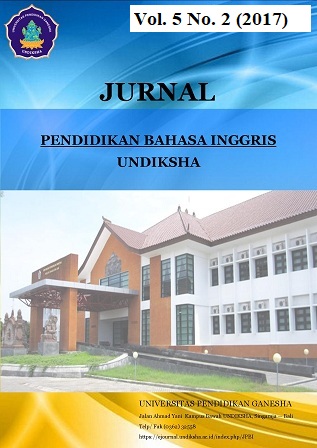AN ANALYSIS OF THE MYTH OF CONVENIENCE ON THREE TRAVELOKA ADVERTISEMENTS
DOI:
https://doi.org/10.23887/jpbi.v5i2.13396Abstract
Penelitian ini bertujuan untuk menginvestigasi mitos kenyamanan yang ditemukan dalam tiga iklan Traveloka yang berjudul “Mudik Tapi Rumah Penuh, Traveloka Dulu”, “Susahnya Cari Tiket Mudik, Traveloka Dulu”, “Liburan Harus Tertunda, Untung Pakai Traveloka” melalui analisis tekstual dengan menggunakan pendekatan teori mitologi Roland Barthes. Penelitian ini juga berfokus pada beberapa aspek, yakni aspek sinemathography dan mise-en-schene yang mendukung konsep mitos kenyamanan dalam iklan Traveloka. Dari data hasil penelitian, ditemukan bahwa mitos kenyamanan pada tiga iklan traveloka disampaikan melalui tiga konsep, yakni kenyamanan dalam kemudahan aksessibilitas, kenyamanan yang dalam penghematan uang, serta kenyamanan dalam memberikan pelayanan yang reliabel. Terdapat lima kategori kenyamanan terkait kemudahan aksessibilitas yang diperlihatkan dalam iklan Traveloka, diantaranya akses tanpa batasan jarak, akses tanpa batasan waktu, akses layanan tatap muka yang mudah untuk dipahami, dan pelayanan terpadu satu tempat. Penghematan uang disignifikasikan tanpa ada biaya pembatalan, harga murah untuk daerah tujuan yang populer, pemesanan dengan ‘harga spesial’ setiap hari, dan harga jujur tanpa biaya tambahan. Mitos pelayanan yang reliabel, ditunjukkan melalui transaksi yang terjamin keamanannya dan fitur baru yang bernama “easy reschedule”. Kemudahan aksesibilitas dengan harga yang terjangkau, serta adanya fitur yang memanjakan konsumen berhasil melahirkan nilai baru yakni meningkatnya kepercayaan masyarakat dalam melakukan transaksi online untuk memudahkan aktivitas sehari-hari.Kata Kunci : iklan televisi, mitos kenyamanan, teori mithologi Roland Barthes.
This study was aimed to investigate convenience myth signified in three Traveloka advertisements entitled “Mudik Tapi Rumah Penuh, Traveloka Dulu”, “Susahnya Cari Tiket Mudik, Traveloka Dulu”, “Liburan Harus Tertunda, Untung Pakai Traveloka” through textual analysis by using Roland Barthes’ theory of mythology. This study also focused to dicover the other aspects in the form of chinemathography and mise-en-schene which were supported the convenience myth in Traveloka advertisement. From the data, it found that the convenience myth of three Traveloka advertisements could be divided into three aspects, that were convenience in ease of access, convenience in money saving, and convenience in reliable service. In convenience ease of access, it could be divided into five chategories, that are no space boundary, no time boundary, user friendly interface, and one stop transaction. In convenience of money saving, it signified without any cancelation fee, low price for popular destination, ‘special deals’ book for less any day, and honest price without service fee. The myth of reliable service showed through a secure transaction guarantee and a new “easy reschedule” feature. The ease accessibility with an affordable price, supported with features that pampered the costumer has succeed in creating a new value to increase public trust in conducting online transaction on daily activity.
keyword : myth of convenience, Roland Barthes’ theory of mythology, television’s advertisement.
Published
2018-02-22
Issue
Section
Articles
License
Authors who publish with the Jurnal Pendidikan Bahasa Inggris Undiksha agree to the following terms:- Authors retain copyright and grant the journal the right of first publication with the work simultaneously licensed under a Creative Commons Attribution License (CC BY-SA 4.0) that allows others to share the work with an acknowledgment of the work's authorship and initial publication in this journal
- Authors are able to enter into separate, additional contractual arrangements for the non-exclusive distribution of the journal's published version of the work (e.g., post it to an institutional repository or publish it in a book), with an acknowledgment of its initial publication in this journal.
- Authors are permitted and encouraged to post their work online (e.g., in institutional repositories or on their website) prior to and during the submission process, as it can lead to productive exchanges, as well as earlier and greater citation of published work. (See The Effect of Open Access)













